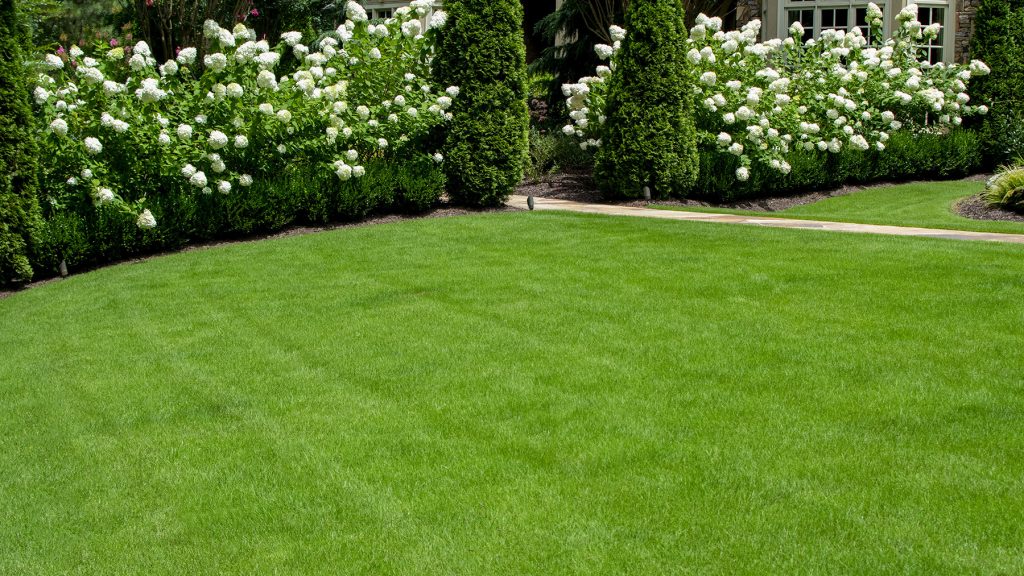Oasis Landscapes & Irrigation provides complete lawn maintenance for metro Atlanta residents. We employ qualified technicians to evaluate and maintain the health of your plants, trees, and turf areas to create a consistently beautiful property.

Our regular maintenance keeps your lawns healthy and also treats fungal diseases and dry patches. And Georgia’s infamous heat and humidity won’t just affect your grass. Gray-white fuzzy mildew can form on shrubs like crape myrtles and Euonymous. If you notice brownish patches, mildew or other problems across your yard, please contact our maintenance team to schedule treatment right away.
During the hottest days of the year, trees, shrubs, and grass need about one inch of water per week. Metro counties restrict watering to three times per week. If you have a sprinkler or home irrigation system installed, make sure it functions properly, and lines, spigots, and spouts are not blocked. If you don’t yet have an irrigation or watering system, we have many options, from low-tech sprinklers to high-tech zoning systems. Contact us today to learn more!
Aeration & Overseeding is the process of bringing new life to your lawn by allowing water and fertilizers to reach the roots and maintaining a healthy, thick appearance. Aeration reduces soil compaction and boosts root growth by removing plugs of soil from the ground and placing them on the turf’s surface. Overseeding means planting additional seeds in your lawn for thicker, bug and disease resistant growth
Rich, continually green fescue is a favorite grass for lawns in much of the USA, including Georgia. Fescue is a cool-season grass, meaning it can endure cold winter temperatures, but experiences a decline during the heat of the summer. When fall weather arrives, it’s time to take some necessary steps to keep your fescue lawn healthy. Here are a few tips to ensure your fescue lawn looks great this winter and next spring:
During the winter season, Keep mowing to a minimum. A fescue lawn is best cut at 2 1/2 to 3 inches. It is important not to trim the growth too short and use a quality lawnmower with sharp blades. Remove no more than the top third of the blade with each mowing. With fescue, you don’t need to worry about picking up the clippings. They return moisture and nutrients to the turf and don’t cause thatch to build up.
In Georgia, fescue is pretty much fried by mid-summer and starts growing again in September. That’s why it’s important to feed this grass during the fall and winter. You can apply fertilizer several times between September and May. This is also a good time to add lime to sweeten your soil. A soil test can help you determine what nutrients are necessary for your lawn.
The best way to deal with weeds is to prevent them. To do this, apply crabgrass pre-emergent in early spring to help keep away summer weeds like foxtail grass, poa annua, and crabgrass. You can use a broadleaf herbicide at any time, either as a spot treatment for individual weeds or broadcast over the entire lawn.
After summer, fescue has been stressed and is susceptible to disease and insect damage. In this case, it’s best to seek help from a professional lawn care company to identify and treat the problem. A professional will have more tools for treatment in his arsenal, as well as the knowledge to apply them safely.
Aeration is an essential aspect of fall care for fescue lawns. Aeration opens up the heavy clay soil that may have become compacted during the year and allows nutrients and water to get to the turf’s roots. This aids in root development and helps new grass seeds germinate.
Fescue doesn’t spread, which is why your fescue lawn may be a bit patchy by the end of summer. September through October is the perfect time to reseed fescue. As long as the seed is kept moist with daily watering for several weeks, it will germinate freely. However, you shouldn’t overseed too early, as this will be detrimental to the grass’s health in the long run.
Remove as many fallen leaves as possible from your lawn before putting seed down. Too many fallen leaves will smother fescue seedlings. Avoid raking leaves, as this would disturb the emerging fescue. The proper caring for your fescue grass will result in a gorgeous, healthy lawn all year long. Just like many other things, it is all a matter of timing.
4958 Winters Chapel Road
Atlanta, GA. 30360
(770)913-9033
2667 Holly Street
Canton, GA. 30115
(678)493-9236
Home » Turf Management
© Copyright 2025 Oasis Landscapes & Irrigation | Designed and hosted by Synergetic Media